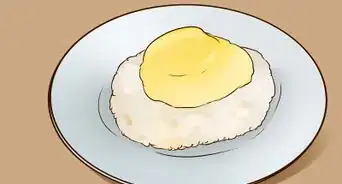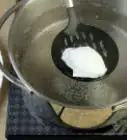This article was co-authored by wikiHow Staff. Our trained team of editors and researchers validate articles for accuracy and comprehensiveness. wikiHow's Content Management Team carefully monitors the work from our editorial staff to ensure that each article is backed by trusted research and meets our high quality standards.
There are 7 references cited in this article, which can be found at the bottom of the page.
The wikiHow Video Team also followed the article's instructions and verified that they work.
This article has been viewed 79,801 times.
Learn more...
Boiled eggs are a delicious and nutritious way to add some extra protein to your meal, or they can be enjoyed on their own as a tasty snack. Believe it or not, you can actually soft-boil or hard-boil your eggs using an electric kettle. It’s super simple and easy to do, and all you need to make it happen is an electric kettle that doesn’t have exposed coils in the bottom of it, which will burn the eggs.
Steps
Soft-Boiling the Eggs
-
1Place the eggs in the electric kettle. Pop open the lid of the kettle, take the eggs out of the carton or container, and gently place them into the kettle so they don’t crack. Don’t fill the kettle more than halfway full with eggs or they may not cook evenly.[1]
- Be careful not to shake the kettle or allow the eggs to roll around to keep them from cracking.
-
2Cover the eggs with 1 inch (2.5 cm) of water. Carefully hold the kettle beneath a faucet and pour cool water into it. Make sure you don’t shift the eggs around too much so they don’t crack. Fill the kettle until the water is 1 inch (2.5 cm) above the eggs.[2]
- Use cool water so you don’t overcook the eggs.
Did you know?
You can tell if an egg is good or bad by placing them in water. If the egg sinks to the bottom of the water, then it’s still fresh. If it floats to the top, then it’s bad!
Advertisement -
3Turn on the kettle and allow it to come to a boil. Make sure the kettle is plugged in and flip the switch to turn it on. Wait until the water comes to a boil and the kettle turns off on its own. If your kettle doesn’t turn off once it reaches a boil, then turn it off yourself as soon as the water starts bubbling.[3]
-
4Remove the eggs and place them into a bowl of cold water. Fill a medium to large-sized bowl with cold water and place it near the kettle. Use a pair of tongs or a large spoon and take the eggs out of the kettle and gently place them into the bowl of cold water so they stop cooking.[4]
- It’s important that the water in the bowl is cold so the eggs don’t continue to cook after you remove them.
- You can toss a couple of ice cubes in the bowl of water to cool the eggs even faster.
-
5Peel and eat the soft-boiled eggs once they’re cool to the touch. Start peeling a soft-boiled egg by tapping the top of it lightly with a spoon to crack it. Then, use your fingers to carefully lift the shell off of the egg. Continue lifting the shell from the surface of the egg until it’s completely removed.[5]
- Soft-boiled eggs can be enjoyed on their own with a pinch of salt and some fresh cracked pepper, or you can add them to a tasty dish like the top of some avocado toast or in a bowl of ramen noodles.
Hard-Boiling the Eggs
-
1Place the eggs into the kettle and cover them with water. Carefully set the eggs inside of the kettle, making sure you don’t drop them or shake the kettle so they don’t crack. Fill the kettle with cool water until the eggs are covered with about 1 inch (2.5 cm) of water.[6]
- Make sure you use cool water so you don’t start cooking the eggs!
- Avoid filling the kettle more than halfway full with eggs so they cook evenly.
-
2Turn on the kettle and let it come to a boil. Plug in the kettle and press the button or switch that turns it on to start it up. Leave it undisturbed until it comes to a boil and turns off automatically. If your kettle doesn’t automatically turn off once the water reaches a boil, wait until the water is bubbling away and then turn it off.[7]
-
3Leave the eggs in the kettle for 15 minutes, then transfer them to cold water. Set a timer for 15 minutes and allow the eggs to simply soak in the hot water and cook. Fill a bowl with cool water and place it near the kettle. Once the timer goes off, use a spoon or a pair of tongs to remove the eggs from the water and place them into the cool water.[8]
- The cool water will stop them from cooking further and will allow you to pick them up without burning your hands.
- Set a timer on your stove or on your phone so you can hear it and the eggs won’t overcook.
Tip: If you like your hard-boiled eggs just a little softer, set the timer for 13 minutes instead of 15.
-
4Peel the eggs and eat them or store them in your refrigerator. An easy way to peel stubborn hard-boiled eggs is to tap the bottom of the egg a few times on your sink or countertop to crack it, then use your fingers to start lifting the shell from the bottom. If bits of the shell are stuck on the egg, hold the egg under running water as you peel to loosen them. You can then eat the eggs, or place them in a container in your refrigerator for up to a week.[9]
- Hard-boiled eggs are great on their own with some salt and pepper, but you can also chop them up and toss them into a salad to add some extra protein!
Community Q&A
-
QuestionMy gran used to use a separate pot to boil eggs as she claimed that toxins cane off the shells whilst boiling. Is there any truth in this?
 Ashley KCommunity AnswerEggshells are edible and packed with calcium. No toxins should come off the shells when boiling.
Ashley KCommunity AnswerEggshells are edible and packed with calcium. No toxins should come off the shells when boiling.
Warnings
- Use a pair of tongs or a large spoon to remove the eggs from the hot water so you don’t burn yourself.⧼thumbs_response⧽
Things You’ll Need
- Electric kettle without exposed coils in the bottom
- Medium to large-sized bowl
- Pair of tongs or a large spoon
- Container (if you plan to store them in the fridge)
References
- ↑ https://www.bhg.com.au/boil-egg-electric-kettle
- ↑ https://www.cleaneatingmag.com/recipes/kettle-noodle-soup-recipe
- ↑ https://youtu.be/b-CoXS4KKOE?t=34
- ↑ https://youtu.be/b-CoXS4KKOE?t=35
- ↑ https://www.bonappetit.com/story/jammy-ramen-egg
- ↑ https://www.cleaneatingmag.com/recipes/kettle-noodle-soup-recipe
- ↑ https://youtu.be/b-CoXS4KKOE?t=36
- ↑ https://www.bhg.com.au/boil-egg-electric-kettle
- ↑ http://www.eatbydate.com/hard-boiled-eggs-shelf-life-expiration-date/




















































